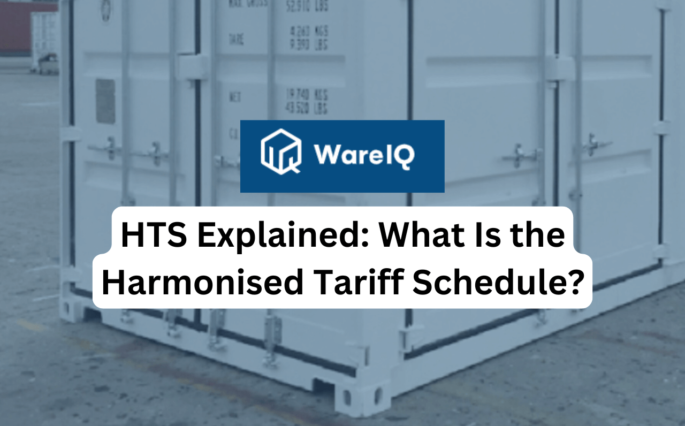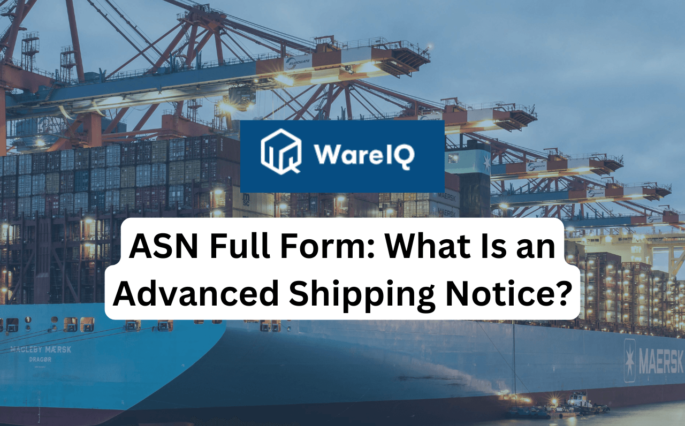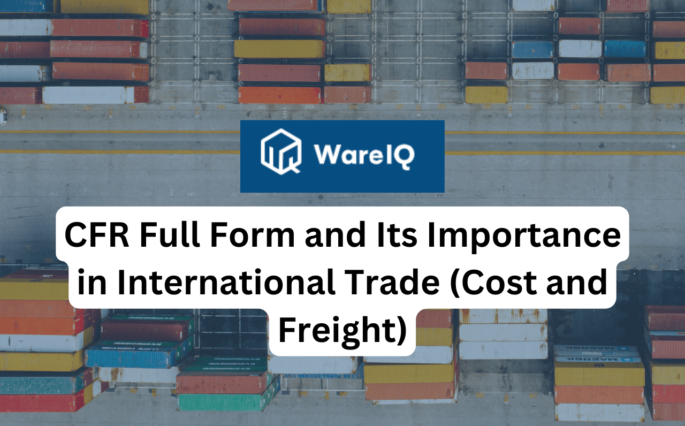Product Bundling in eCommerce: Definition, Types, Advantages & Strategies for Online Sellers to Capitalise on Selling Product Bundles in 2025

Even eCommerce retailers are the customers of other brands in other industries. Customers often browse through multiple product listings and end up purchasing the option that gives them the best deal such as buy one get one extra, free delivery if the purchase value is of a certain amount and buy 3 products for a 10% discount on each, among others.
This business trick is called product bundling and it is mainly used to increase the average order value of a business. In this article, we will learn all about how product bundling works, how it is implemented, strategies for online sellers, and ways to get better output while implementing a win-win situation for yourself as well as your customer.
What is Product Bundling?
Product bundling in eCommerce refers to several products or services sold together as a combined package to offer customers a better offer than if they were sold individually by a seller. Groom kits, sets of soap, value meals at restaurants and other products are a few examples of product bundles. Some companies only offer specific best-selling products in bundles rather than individually to entice customers to try other products along with their best-sellers. Product bundles are a well-liked strategy used by eCommerce retailers to sell more of their goods and raise their revenues over time.
WareIQ, an eCommerce fulfillment company, empowers online brands with a superior-tech platform to compete with Amazon like service levels by bringing their average delivery timelines from 5-10 days to 1-2 days.
Types of Product Bundling
Pure Bundling
Pure product bundling prohibits the sale of individual products that make up the bundle separately. Instead, they can only be bought together at bundle pricing. The options available to the consumer are constrained by this strategy. For Example, many companies only offer trips or insurance for families instead of providing options for an individual.
Mixed Bundling
Customers can purchase particular products in mixed bundles or as standalone ones, at bundle pricing or standard pricing. A consumer at a fast-food restaurant, for instance, has the option of purchasing a single burger or a bundle value meal.
Mix and Match Bundling
The mix-and-match product bundling method enables customers to choose from a variety of related products. Brick and mortar retailers typically do this for quickly moving consumer goods like perishables or bulk items. Here, you list a few things for your consumers to select from and they can put the selections together to create a unique bundle. This technique raises the item’s perceived worth by making the customer feel like they have direct control over what they purchase. It is the ideal strategy for pushing your clients to buy products in quantity and at bundle pricing without pressuring them to purchase things they don’t want.
Similar Item Bundling
Customers that wish to buy a lot of things at once will benefit from using this strategy, which is similar to bulk buying. This technique is typically used with items that get depleted quickly. Examples of such products are conditioner with shampoo, face wash with face cream, etc.
New Product Bundling
In this strategy, newly launched products are promoted alongside more established or well-liked products to get clients to purchase your most recent offering. eCommerce shops employ this strategy, combining new products with existing well-known stock to increase visibility for the new offering. The more well-liked the current product is, the closer the customer is brought to the new product. Examples include new series of watches sold with mobile phones at bundle pricing by respective brands.
Gift Set Bundling
Gift packages are designed for customers who wish to present a loved one with a collection of complementary products. Most of the time, holiday seasons are when this kind of bundle is sold. As the name implies, this kind of bundling aids consumers in selecting gifts for friends. This is based on the idea that a present is better if it includes more items. When consumers are shopping for useful items over the holidays, this form of bundling is extremely common. For example, a grooming kit consists of several products.
Cross-Sell Bundling
As an add-on to a primary product, retailers sell a complementary product using this product bundling strategy. With less expensive things or with parts or accessories that match a more expensive item, this form of product bundling is effective. For example, when you buy a laptop, you may also purchase a bag or a charger.
Buy One, Get One Free or Half-Price Bundling
This type of product bundling is when consumers purchase one major item, they can save money on or receive a free additional item by combining them. This method works best for one-time purchase products. In the case of electronics, for instance, a client who purchases a laptop would not return to the store to purchase the same item. Giving your consumers a free item, a discount, or a gift card can thus encourage them to add more things to their carts at bundle pricing.
By including extra features or products in your current purchase, product bundling increases the value of your sale. To meet your clients’ preferences and satisfy their desires, you can adjust your product offerings. Offering distinctive and expertly designed product bundles can make you stand out from your rivals. It raises the perceived worth of your products in the eyes of your customers, clears out your stale inventory and increases sales.
Inventory Clear-Out Bundling
If you want to get rid of outdated inventory or simply create room for seasonal goods, this strategy is quite effective. To quickly remove it from your inventory, combine well-liked products with the stock of non-moving or outdated goods. Even when older products sell for less, this strategy aids in cost recovery.
Occasional Bundling
This approach maximizes the festive season and unique events. For instance, when it comes to Valentine’s Day, you frequently see a combination of flowers, cards, wine and chocolates packaged together for people who wish to celebrate with their special someone.
Advantages of Product Bundling
To Retailers
Increases Your Average Order Value (AOV)
Over time, product bundling may boost individual item sales and profitability. Your average order value will go up if you bundle your products together to encourage buyers to buy many items at once. For example, if you are a sports item seller, you may give customers a choice so that while buying a bat, they can choose to buy balls and wickets, making them purchase more than a single product which increases your average order value (AOV).
Decreases Marketing and Distribution Costs
You can sell more products and spend less on marketing and delivery by using product bundling. You can combine complementary products and offer them as one bundle rather than promoting each product separately. When you package various things together, you only need one warehouse to keep them, as opposed to multiple. Bundling also reduces the number of boxes of individual things you need to ship and reduces the cost of postage. Instead of creating print and online advertisements for each product, you can group them to save money on marketing expenses while simultaneously promoting all of your goods.
Reduces Inventory Wastage
Unsold goods remain in your inventory as dead stock, increasing your holding expenses before needing to discard them. Bundling can be used to get rid of this dead stock before it becomes an issue. Customers will view the bundle as a deal and be more likely to purchase it if you combine a slow-moving or stagnant item with a faster-selling product. This lowers your inventory holding costs, decreases waste and frees up warehouse space.
Aids in Product-Line Expansion
Online shopping for single inexpensive things typically has two unsatisfactory options – either the vendor pays for shipping but loses money on the sale or the customer pays more for shipping than the item itself. eCommerce businesses can grow their product lines by bundling products at an order-value threshold in a way that benefits both customers and sellers.
To Consumers
Product bundles frequently provide discounts. Bundles are the ideal option if buyers plan to buy the contents of the bundle anyway. Customers will often compare prices on the package to obtain the greatest deals. If you are looking to price your products for more profitability, you can experiment with product bundling.
They Can Try Out Different Products
Customers can sample new products or product ranges that they might not have otherwise had the opportunity to try thanks to product bundling. Customers can be given complimentary goods to try when buying certain products.
They Don’t Need to Waste Time Researching Multiple Products
Product bundles naturally combine complementary solutions. As a result, buyers don’t need to conduct any research to see whether those items would integrate or be of use to them. As a result, the purchasing process is expedited and the user experience becomes frictionless.
They Can Personalize Their Order
Make bundles specific to the buyer’s needs so that they are not restricted to buying products that they don’t want or need. In such a scenario, a person can opt to choose multiple products that will add value to their initial order so that they perceive they are getting a better deal.
Usage of Product Bundling in Marketing
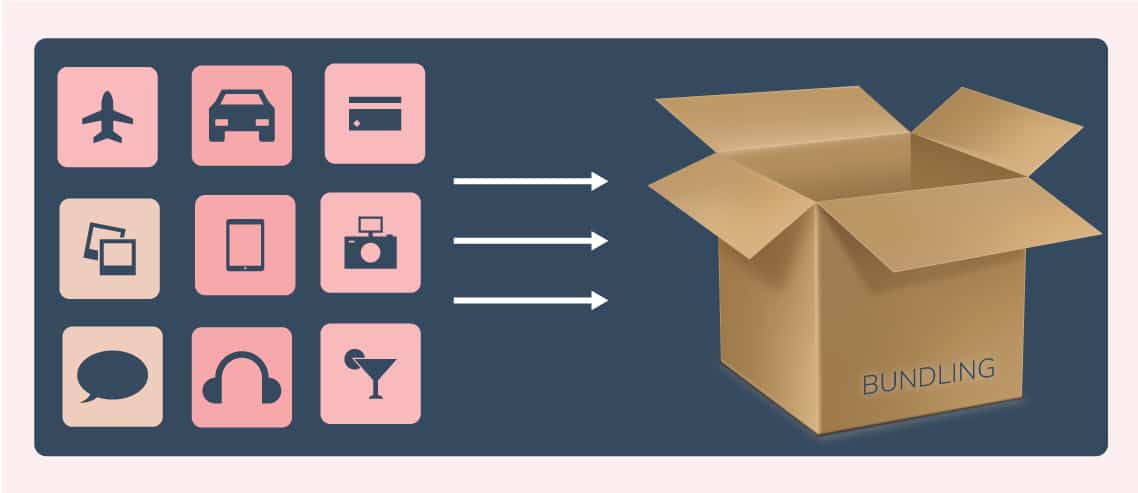
Creates a Positive Impression of Your Brand
Customers will view an offer as more of a deal if it contains a reduced or free item than if the two items were sold separately. You can provide your consumers with the most value for their money while simultaneously increasing your sales by providing additional product bundling.
Saves Time and Marketing Costs
Product bundling helps marketers save time. It is significantly simpler for staff to stock (especially for physical products) and the products can be sold as a package deal, which reduces the number of products you need to promote to just one instead of multiple.
Provides Seasonal Opportunities
You can entice clients to buy more products by bundling them during busy periods of the year, such as the holidays or summer sales, by instilling a sense of urgency or FOMO. Also, during festivals, you can spend extra on campaigning and marketing and you can save money by promoting the items as one unit instead of separately.
Enables You to Sell More Products to Customers
Customers have more options and greater value with product bundling, especially if the package includes things they need. Customers are typically more likely to select a well-made bundle over a product that is sold separately.
Reduces Shipping Costs
As you are sending things in bulk, bundling them together and offering a discount results in lower overall shipping costs as only one package is being shipped as opposed to multiple shipments.
Tips to Capitalize on Selling Product Bundles in 2025
In this section, we will look at how to offer product bundles as well as the criteria you should use to measure your success for year 2025.
Understand Your Customers
Keep proper knowledge of your target customer base. Observe the factors that motivate people to buy particular products even if you may already have information on your consumers in your CRM system, including historical sales and purchasing behaviour. Look at the things they do not buy collectively as well as what they buy collectively and when. You can begin to develop specialized product bundles and strategies after you have a better understanding of consumer behaviour.
Create Bundles Accordingly
Find what customers regularly purchase and based on the data, create product bundling that fulfills their expectations. Choose solutions that will appeal to clients by considering the complementary products from your range that you can sell together. Create varied product packages as a final step to ensure that there is something for everyone. Products that your customers have purchased earlier and are likely to buy again should be included in your bundles as this will assure repeat business rather than one-time sales.
Offer Better Deals
Customers are constantly seeking the greatest deal. They are constantly on the lookout for the best deals and discounts. Consider giving your bundles a discount to increase your sales. Without affecting your profit margins, this will greatly improve the attraction of your products.
Choose a Product Bundling Strategy
To make your goods stand out, here are a few product bundling strategies that will bring value to your bundles:
- Price anchoring
- eCommerce Flash Sale (time-limited) bundles
- Put bundles in the most visible areas
- Bundle products according to themes
- Show the savings and the deal advantages
- Consider personalization
Manage Analytics and Optimize Decision-Making
You can evaluate the effectiveness of your product bundling methods using the metrics listed below:
- Average Order Value (AOV)
If your Average order value per customer increases then find out which bundles are doing well and the reason behind it.
- Product Growth Annually
You can determine whether an item is doing well as a standalone item by looking at its sales history over a year. If not, think about combining it with a high-performance product and keep an eye on the outcomes.
Conclusion
It is worth considering how you can use product bundling in your sales and marketing plans if you offer items or services because it’s been a successful marketing technique in every industry and continues to be practised both online and offline. If you need assistance with storing and fulfilling your product bundles, consider partnering with WareIQ.
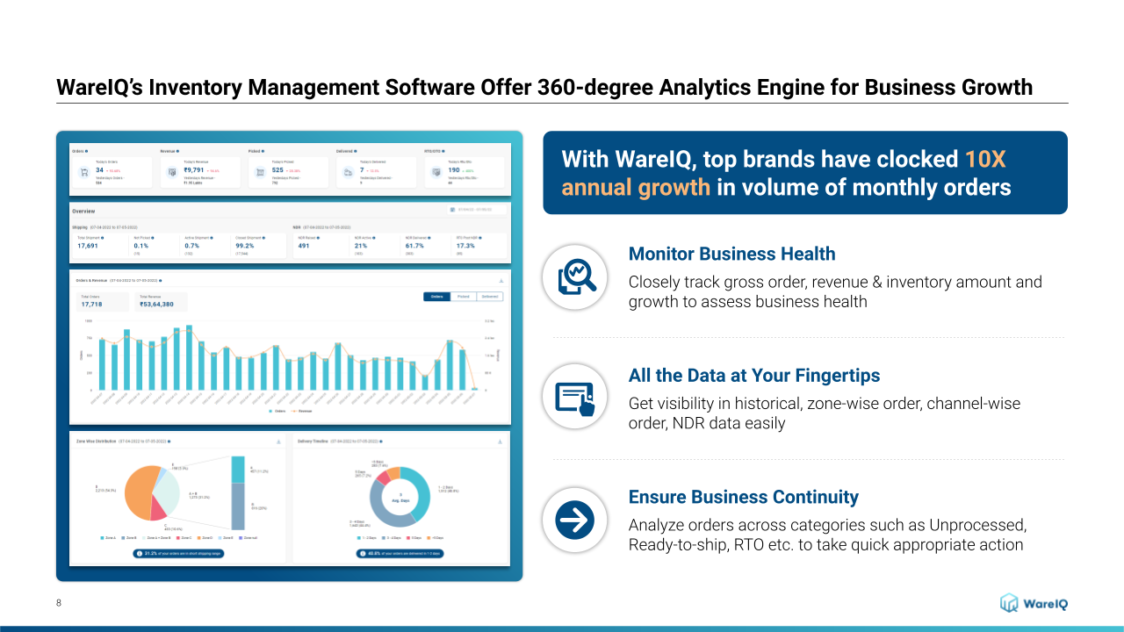
WareIQ helps you analyse historical data to identify which strategies are effective, driven by the real-time purchases of buyers. While managing inventory, we can identify the sales rate of each product and show you the top and bottom-performing products to make it clear which items require product bundling. Our WMS software will calculate the cost of your bundling and can give you better bundle pricing after optimizing the storage cost of the product. You also only pay for the storage space and services you use. We also offer multiple other eCommerce fulfillment services such as a nationwide network of fulfillment centers and partnerships with more than 20 of the largest shipping aggregators in the country.







